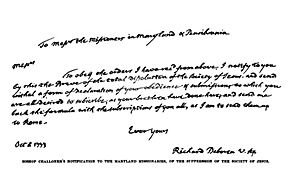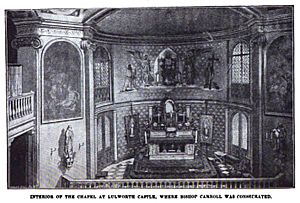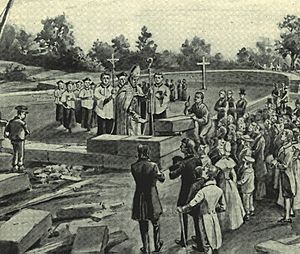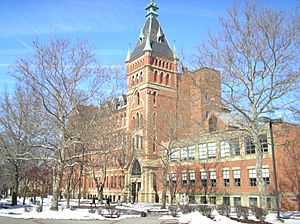John Carroll (archbishop) facts for kids
Quick facts for kids The Most Reverend John Carroll SJ |
|
|---|---|
| Archbishop of Baltimore | |
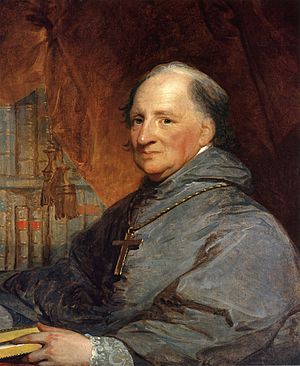
Portrait by Gilbert Stuart, c. 1806
|
|
| Church | Catholic Church |
| Province | Baltimore |
| See | Baltimore |
| Appointed | November 6, 1789 |
| Enthroned | December 12, 1790 |
| Reign ended | December 3, 1815 |
| Predecessor | Diocese erected |
| Successor | Leonard Neale |
| Orders | |
| Ordination | February 14, 1761 |
| Consecration | August 15, 1790 by Charles Walmesley |
| Personal details | |
| Born | January 8, 1735 Marlborough Town, Province of Maryland |
| Died | December 3, 1815 (aged 80) Baltimore, Maryland, United States |
| Motto | Ne derelinquas nos domine deus noster (Forsake us not, O Lord, my God, stay not far from me) |
| Styles of John Carroll |
|
|---|---|
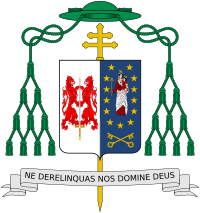 |
|
| Reference style | The Most Reverend |
| Spoken style | Your Excellency |
| Religious style | Monsignor |
| Posthumous style | none |
John Carroll (born January 8, 1735 – died December 3, 1815) was an important American Catholic leader. He became the first Bishop of Baltimore and later the first Archbishop of Baltimore. This was the first Catholic diocese in the new United States.
Before 1808, John Carroll was in charge of the entire Catholic Church in the U.S. He was a member of the Jesuits, a religious order, until it was temporarily stopped in 1773.
Born into a well-known family in colonial Province of Maryland, Carroll spent many years in Europe. He taught and worked as a chaplain (a religious leader for a group). When he came back to Maryland in 1773, he helped organize the Catholic Church in America. The Vatican gave him several leadership roles, eventually making him an archbishop.
Carroll also started Georgetown University in Washington, D.C.. He founded St. John the Evangelist Parish in Silver Spring, Maryland. This was the first parish in the country led by priests who were not part of a religious order.
Contents
Early Life and Education
John Carroll was born on January 8, 1735, in Upper Marlborough, Maryland. His parents were Daniel Carroll I and Eleanor Darnall Carroll. He grew up on his family's large farm.
- John's older brother, Daniel Carroll II, helped create the United States. He signed both the Articles of Confederation and the United States Constitution.
- His cousin, Charles Carroll, was the last person to sign the United States Declaration of Independence.
John Carroll was first taught at home by his mother. Then, he went to a secret Catholic school in Maryland. At that time, Maryland laws did not allow Catholic schools. The school was run by a Jesuit priest. When he was 13, John and his cousin Charles went to the College of St. Omer in France. This school was popular for boys from wealthy Catholic families in Maryland.
Becoming a Jesuit Priest
John Carroll joined the Society of Jesus (Jesuits) when he was 18 years old in 1753. In 1755, he began studying philosophy and theology at a Jesuit school in Belgium. After 14 years, he became a deacon.
On February 14, 1761, Carroll became a priest in Belgium. He officially became a Jesuit in 1771. Carroll stayed in Europe until he was almost 40. He taught at schools and worked as a chaplain for a British noble.
In 1773, Pope Clement XIV stopped the Jesuit order for a time. This was a difficult experience for Carroll. He returned to his family's farm in Maryland. Since Maryland laws did not allow Catholic parishes, Carroll worked as a missionary. He traveled and served Catholics in Maryland and Virginia. In 1774, he built a small chapel on his family's farm.
Helping the American Revolution
In 1776, the Continental Congress asked John Carroll to join a special trip to Canada. His cousin Charles Carroll, Samuel Chase, and Benjamin Franklin were also part of this group. Their goal was to convince the French people in Canada to join the Thirteen Colonies in the American Revolution.
However, this trip was not successful. The bishop of Quebec did not allow his priests to meet with Carroll and the others. When Benjamin Franklin became sick, Carroll helped him travel back to Philadelphia. Carroll then returned home and continued his religious duties during the war.
Leading the American Catholic Church
After the American Revolution, the Catholic Church in the United States needed a new leader. Before, it was overseen by a bishop in England. But after the war, Americans did not want British leaders.
In 1783, Carroll started holding meetings to plan the future of the American Catholic Church. He and others also began raising money to build Georgetown College. This school would educate Catholic men and women in Maryland.
The priests in Maryland felt it was too soon to have an American bishop. However, Pope Pius VI appointed Carroll as the temporary leader of the Catholic missions in the United States in 1784. He was given the power to perform the sacrament of confirmation.
New Church Structure
In the new United States, the Catholic Church was not controlled by the government. Without much contact with the Vatican, local churches sometimes set their own rules. Carroll worked to create a church structure that allowed some involvement from regular church members. At the same time, he wanted to keep a clear leadership structure.
Carroll also wrote articles to correct false information about Catholics. He believed that Catholics and Protestants should work together. He thought that two main things made Christian unity difficult: unclear rules about the Pope's power and the use of Latin in church services.
First Bishop of Baltimore
After the American Revolution ended in 1783, the Vatican officially created the Apostolic Prefecture of the United States in 1784. Carroll was named its leader.
In 1785, Carroll wrote to the Vatican about the Catholic Church in Maryland. He said that even though there were only 19 priests, many important families were still Catholic. He also asked the Vatican to let American priests help choose their first bishop. This would help ease fears of too much control from Rome.
Pope Pius VI agreed to Carroll's request. The priests in Maryland voted, and in April 1789, they chose Carroll to be the first bishop of Baltimore.
On November 6, 1789, Pope Pius VI officially appointed Carroll as bishop. He was made a bishop in England on August 15, 1790. When the Diocese of Baltimore was created, it covered all the Catholic areas in the United States east of the Mississippi River.
Carroll chose the Church of St. Peter in Baltimore as his main church. It was the first Catholic church in Baltimore. This church hosted the first meeting of American priests in 1791. It also saw the first ordination of a priest (1793) and the first consecration of a bishop (1800) in the United States.
In 1790, Carroll sent a message of congratulations to the new President George Washington from all American Catholics. In 1795, the Vatican appointed another bishop, Leonard Neale, to help Carroll.
Later, Carroll was given authority over the Catholic Church in the Danish West Indies (1804) and the Louisiana Territory (1805).
Founding Georgetown University
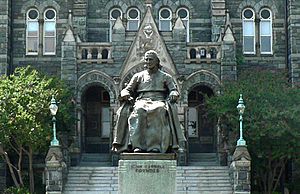
Since 1783, Carroll had worked hard to build a Catholic school. He wanted a place to train American priests and educate Catholic people. Construction of Georgetown College began in 1788 in Georgetown, which is now part of Washington, D.C. The college opened on November 22, 1791. Today, there is a statue of Bishop John Carroll at the university.
First Church Meeting
In 1791, Carroll held the first meeting of priests and deacons in American history. Twenty-one priests attended this meeting in Baltimore. They discussed important topics like:
- The sacraments of Baptism, Confirmation, and Penance.
- How to celebrate Mass and other prayer services.
- Rules for marriages between Catholics and non-Catholics.
- Rules for fasting and abstinence.
These rules were the first local laws for the Catholic Church in the new nation. One rule said that churches should divide their money. One-third would support the clergy, one-third would maintain the churches, and the rest would help the poor.
Religious Orders in the Diocese
To train priests, Carroll invited the Sulpician Fathers from France to Baltimore. They arrived in 1791 and started St. Mary's College and Seminary. Carroll also approved the establishment of the Order of the Visitation of Holy Mary in Baltimore.
In 1805, Carroll helped bring back the Jesuit Order in Maryland. He did this by connecting with Jesuits in Russia, who had been protected from the suppression by Catherine the Great. That same year, Carroll encouraged Dominican friars from England to open a school in Kentucky. In 1809, the Sulpicians invited Sister Elizabeth Ann Seton to start a school in Emmitsburg, Maryland.
Building the First Cathedral
By the early 1800s, the Diocese of Baltimore needed a larger church. In 1806, Carroll began building the first cathedral, the Cathedral of the Assumption in Baltimore.
The famous architect Benjamin Henry Latrobe, who also designed the United States Capitol building, designed the new cathedral. Carroll laid the first stone of the new cathedral on July 7, 1806.
Becoming an Archbishop
In April 1808, Pope Pius VII made the Diocese of Baltimore an archdiocese. This made it the first archdiocese in the United States. The Pope also divided the country into four new dioceses under Baltimore:
- The Diocese of Boston (covering New England).
- The Diocese of New York (covering New York and part of New Jersey).
- The Diocese of Philadelphia (covering Pennsylvania, part of New Jersey, and southern coastal states).
- The Diocese of Bardstown (covering new states and territories in the Midwest).
Pope Pius VII named Carroll as the first archbishop of Baltimore. He then helped make other bishops. In 1808, he consecrated Michael Francis Egan as the first bishop of Philadelphia. Two years later, he consecrated Jean-Louis Lefebvre de Cheverus as the first bishop of Boston and Benedict Joseph Flaget as the first bishop of Bardstown.
Death
John Carroll passed away in Baltimore on December 3, 1815. He is buried in the crypt of the Basilica of the National Shrine of the Assumption of the Blessed Virgin Mary.
His Beliefs
Using English in Church
During Carroll's time, church services were mostly in Latin. Many Catholics could not understand the Bible or the prayers. Carroll strongly believed that Catholics should be able to hear and read the scriptures in English. He wanted priests to perform readings in the language people spoke. He supported the "Carey Bible," an English translation, and encouraged people to buy it.
Carroll pushed for using everyday languages in church services, but the Vatican did not agree at the time. He wrote that it was "preposterous" (meaning ridiculous) to use an "unknown tongue" when most people didn't understand it. It took almost 200 years for English to be widely used in Catholic services in the United States, after the Second Vatican Council.
Views on Slavery
John Carroll believed that enslaved people should be treated kindly and receive religious education. In his early years, he did not call for slavery to end immediately. Later, he supported a policy where slave owners would slowly free their enslaved people over time. He thought this would keep families together and allow for care of the elderly.
In 2018, research showed that Carroll owned two enslaved men, Charles and Alexis, while he was a bishop. He sold Alexis in 1806. In his will, Carroll left Charles to his nephew, with the condition that Charles be freed within a year of Carroll's death. Carroll also left Charles a small inheritance.
Legacy and Namesakes
Many schools and organizations are named after John Carroll:
Schools
- Archbishop Carroll High School – Dayton, Ohio
- Archbishop Carroll High School – Radnor, Pennsylvania
- Archbishop Carroll High School – Washington, D.C.
- John Carroll Catholic High School – Fort Pierce, Florida
- John Carroll Catholic High School – Birmingham, Alabama
- John Carroll School – Bel Air, Maryland
- John Carroll University – University Heights, Ohio
Other Namings
- Carroll Square – an office building in Washington D.C.
- Carrolltown, Pennsylvania – a town founded by a priest.
- John Carroll Society – an organization for Catholic professionals.
- John J. Carroll Institute on Church and Social Issues (JJICSI) – an organization at Georgetown University.
- Mass for John Carroll – a musical mass written in 1990.
See also
 In Spanish: John Carroll (obispo) para niños
In Spanish: John Carroll (obispo) para niños
- Apostolic succession
- Carroll family
- Catholic Church hierarchy
- Catholic Church in the United States
- Historical list of the Catholic bishops of the United States
- List of the Catholic bishops of the United States
- Lists of patriarchs, archbishops, and bishops


